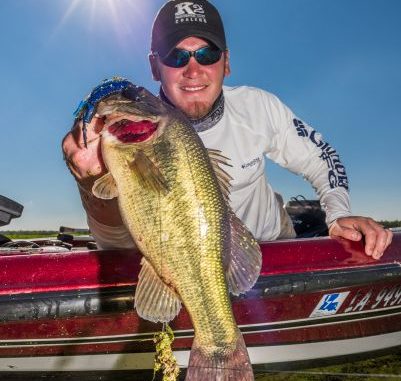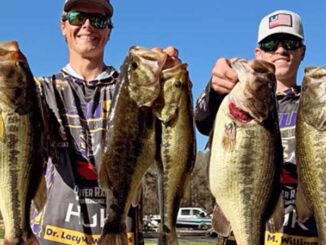
The right rig, attention to detail needed when punching grass
Submerged vegetation is to bass as politics is to lying — you won’t find one without the other.
That means when a nice, thick grass bed forms on pretty much any body of water, bass anglers will be punching soft-plastics through the mats.
But what’s the key to narrowing down the focus when faced with a largely monotonous-looking stretch of cover?
New Iberia’s Caleb Sumrall said it’s all about observation.
“Any variation in a mile of the same thing is what these fish want,” Sumrall said.
That could mean points along the edges of the grass bed or isolated spots of grass separated from the main vegetative body.
It could also mean some anomaly in the heart of the vegetation mat.
“Any time you get two types of grass, you want to fish that,” Sumrall said.
Of course, this also is true if a piece of wood has been swallowed by the mat.
And surface vegetation — namely hyacinths — is just a bit of icing on the cake, Sumrall said.
“I’ll tell you a secret about fishing hydrilla: Any time you see hyacinths on top and it’s stationary, there’s a hole in the hydrilla,” he said. “You want to fish that.”
Paying attention to every detail, even the color of your line, is also important.
“There’s no such thing as over-meticulous — there’s not,” Sumrall said. “I try to pay attention to everything.”
Here’s a rundown of Sumrall’s basic punching rig:
• Line — You can’t get away without braid, and this angler ensures his line is hefty enough to handle the rigors of thick salad. Sixty-pound braid is his preference.
• Weight — Leave the 1/4- and 3/8-ounce — and maybe the 3/4-ounce — weights at home. Effectively punching vegetation means going heavy.
Sumrall uses 1- to 11/2-ounce tungsten weights to drill holes in the mats under which bass hide.
Exactly how heavy, though, isn’t all related to getting through the green stuff, however. Sometimes he goes with a heavier weight than punching through the mat calls for.
The key is what triggers bites, and that often comes down to how fast a lure moves from the mat to the water bottom.
“That’s the No. 1 thing with punching — finding the rate of fall the fish want,” Sumrall said.
• Peg it — If you aren’t pegging your weight, the odds are you won’t catch fish.
Using pegs keeps the weight from slipping through the grass while your lure sits on top, unseen by any bass.
Sumrall orders rubber bobber stoppers like 6th Sense Peg X stoppers from Tackle Warehouse, but Bass Pro and Cabela’s also carry versions.
• Hooks — Sumrall said this is a job for a stout, straight-shanked hook. His preference is a VMC flipping hook sized to fit the lure he fishes on a given day.
This hook has a built-in keeper that really tags soft-plastic lures in place so you don’t have to worry about it pulling down the shank.
• Lure — Beaver-style baits are this angler’s go-to. Specifically, he prefers a Missile D Bomb, which he insists is a fish-catcher.
“When I won that (Louisiana) Sportsman tournament (in 2014), I was in a community hole; there were 10 boats on my starting spot,” Sumrall said. “I caught 20 pounds versus 10 pounds — that was the difference in that tournament.
“You would think it would catch a lot of grass, but it goes through easily.”
Sure, if you have a secret spot no one knows about (and there are a lot of those today, right?), you can punch pretty much anything you want and catch fish. But Sumrall said D-Bombs have a tendency to produce on pressured areas.
• Lure color — Sumrall chooses the color according to the primary bait on which fish feed.
“I like darker colors — something that mimics crawfish — in the (Atchafalaya) Basin,” he explained. “If I go to Toledo Bend, I’m a green pumpkin fanatic because there’s so many bluegill over there.”


